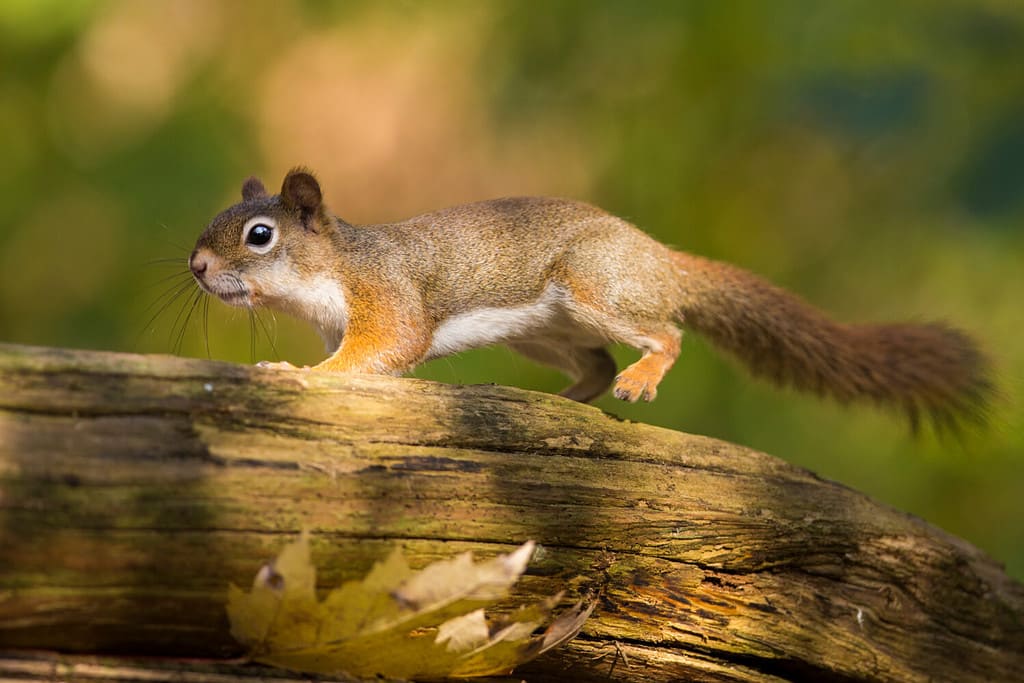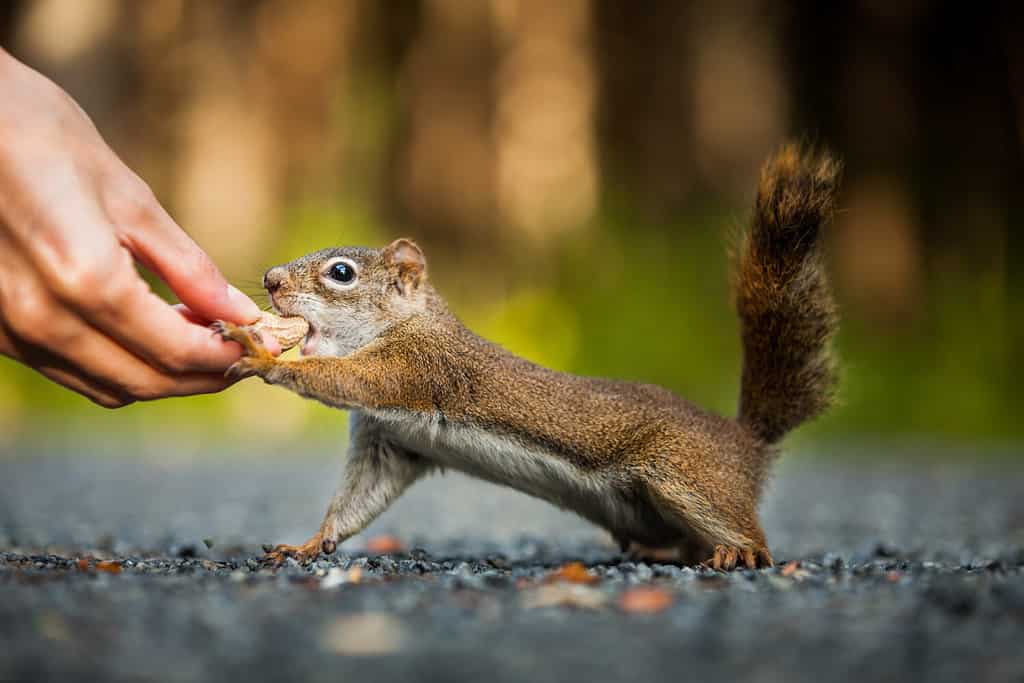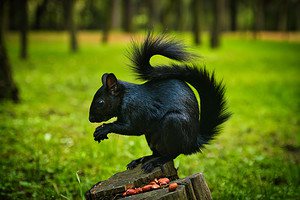If you own a bird feeder or spread feed for some backyard chickens, the odds are good you are familiar with all the sounds squirrels make. They get quite noisy at times and their back-and-forth chatter is occasionally eerie, as if they are carrying on long-winded, complex conversations.
Not all squirrel noises are the same. Like all animals that are susceptible to several predators, squirrels have a variety of warning calls. If you happen to disturb one that’s busy chomping down an afternoon snack, you’ll experience a squirrel’s irritation sounds as well.
Now that we’ve determined that squirrels make a lot of funny sounds, what do each of them mean? Are squirrels attempting to convey something, or is it just a bunch of hodgepodge with meaningless noise? While squirrels probably aren’t communicating their plans to take over the world just yet, their communications are meaningful and worth exploring.
1. High-Pitched Scream

©Mircea Costina/Shutterstock.com
We might as well get the loudest and most violent-sounding squirrel sounds out of the way first. The good news is, you won’t hear this very often unless a squirrel is in imminent danger, such as being cornered or caught. Squirrels make this sound when something suddenly startles them as well.
It’s both a means of communicating danger or, possibly, the final sound it will ever make. Sometimes, if a squirrel recognizes imminent danger (as in the next five seconds), but not necessarily for itself, it will scream.
2. Chattering and Chirping Sounds

Squirrels will frequently chatter and chirp while they’re eating.
©Benoit Daoust/Shutterstock.com
There are a couple of reasons a squirrel may do this. And, they tend to do it at completely random times, including when they’re eating. In terms of all the sounds squirrels make, chattering and chirping are some of the most common.
Both excitement and aggravation are the driving forces behind these particular sounds. A mixture of both is an indication that the squirrel wants to let a rival know what the deal is. A squirrel version of talking smack to another squirrel.
This is also a common sound when you inadvertently scare one away, and It’s waiting for you to go back inside. A squirrel, believe it or not, has a lot of patience. It will sit there in a tree and chatter at you until you leave. Even if it takes several minutes. If you live in any of the southern states, you’re probably used to this from gray squirrels.
3. Barking Sounds

Barking is one of the more common communication methods squirrels use.
©Lateman/Shutterstock.com
No, the squirrels aren’t trying to mimic your pet dogs. Yes, one of the sounds squirrels make is a barking sound. However, it’s not quite the same as the one that comes from dogs. It doesn’t help that squirrels have a much smaller voice box than all but the very smallest dogs.
There’s one thing squirrels and dogs have in common, though, and it’s the reasoning behind the barks. Squirrels typically bark at threats, bark because there are threats, or bark because they are trying to communicate. If your pet dog is outside barking at a squirrel and it’s barking right back, they aren’t having an intelligible argument. One is barking out of excitement, and one is probably barking as a warning to others.
4. Crying Sound

Squirrels won’t cry when it’s cold, but they will if they are hurt or seriously stressed.
©Mircea Costina/Shutterstock.com
Crying sounds squirrels make are their primary means of alerting other squirrels to danger. They also make this sound when they are injured, which makes plenty of sense. Much like other animals and human beings, squirrels cry when they are hurt. It’s not a cry in the sense that tears are flowing from their eyes.
Squirrels do have tear ducts, just not for crying in terms of our understanding. The Richardson’s ground squirrel makes an altogether different kind of cry—an ultrasonic one. It’s the only type of squirrel that makes this call, and it’s primarily used for warning other squirrels of distant but approaching predators.
5. Baby Squirrel Sounds

Baby squirrels have a very distinct, murmuring sound that adult males imitate when seeking a mate.
©Nilanka Sampath/Shutterstock.com
The assumption is that this category only pertains to baby squirrels. The reality is, the baby squirrel makes a kind of “mup-mup” sound, followed by several high-pitched whistles that sound very similar to a variety of bird calls. Adult male squirrels will frequently make a very similar, very quiet mup-mup sound when pursuing a female squirrel.
It’s generally understood that males make this sound to reassure the female squirrel. The male just wants to mate with her, not harm her. The female will make similar, reassuring calls when she’s ready to mate and understands that the male is not chasing her for any other purpose.
6. Squawking Sounds

This squirrel may squawk at you for interfering with its drinking time.
©Sam Robertshaw/Shutterstock.com
One of the more irritating (at least to people) sounds that squirrels make is the squawking sound. This is predominately their argument sound. Highly annoyed squirrels will squawk at another squirrel to make whatever point they want to make. The other squirrel is likely to reciprocate.
People sometimes mistake the squawking sound for other squirrel sounds, since some sounds are very similar. If you can see the squirrels as they squawk, their body language speaks volumes. It’s pretty easy to tell the difference between a frustrated squirrel and a scared squirrel.
Squirrels Communicate In Other Ways As Well
The sounds squirrels make are not their only method of communication. Squirrels also utilize body language. Their body language will tell you what their chatter indicates. For instance, if a squirrel is relaxing and squatting on a tree branch as it chatters and squawks, the noise is likely a territorial or aggravation thing.
If the squirrel is splayed out against the tree trunk or branch and barking away like crazy, it’s probably warning other squirrels of impending danger. Squirrels will also use their tails to point out dangers as well, such as a snake coiled on the ground, or an approaching human.
A lot of their body language is generic, especially when they’re on the move, jumping from tree to tree, playing, or running away with food in their mouths. Squirrels are one of those animals that are often easy to read because they emphasize body language.
Final Thoughts
The sounds squirrels make are both very different and very similar to each other. Sometimes, they’ll make a distinctive, separate sound. Other times, the different sounds resemble each other so much that it’s difficult to tell them apart.
Either way, there’s little doubt that squirrels are highly communicative. If you have a lot of trees in your yard, you probably know this. One of the best ways to learn all the different sounds squirrels make is to put a bird feeder in your yard. If it’s exclusively a bird feeder, a squirrel’s sounds will be the least of your problems.
The photo featured at the top of this post is © My Generations Art/Shutterstock.com
Thank you for reading! Have some feedback for us? Contact the AZ Animals editorial team.







